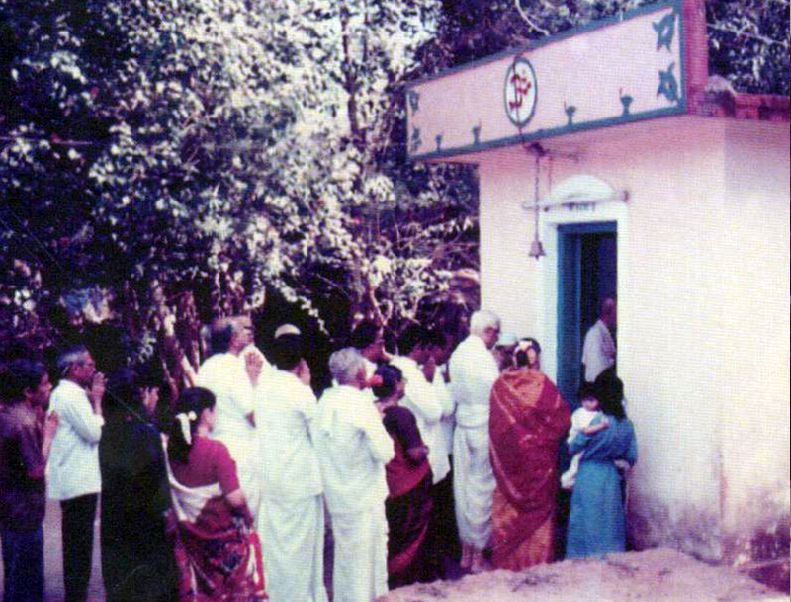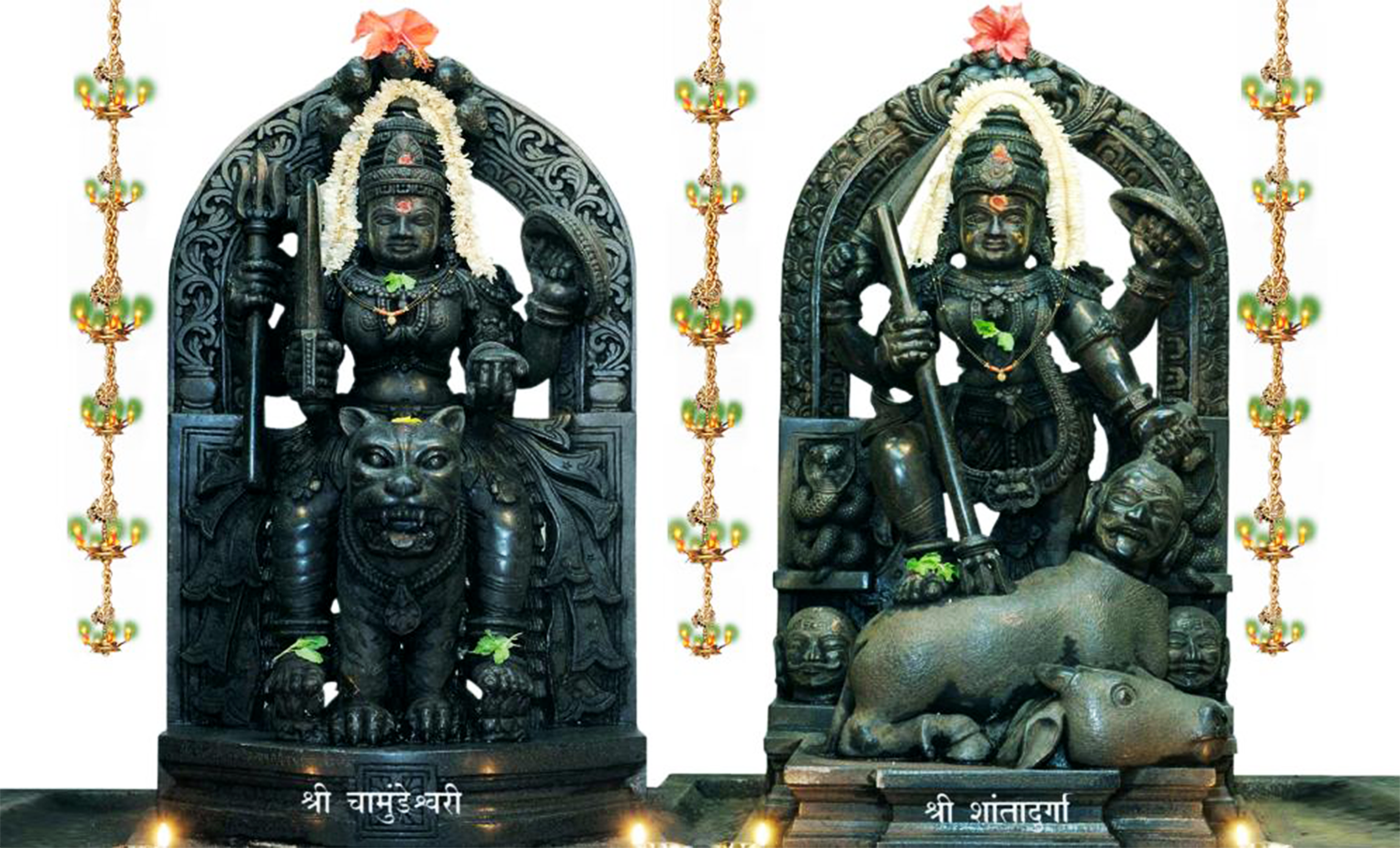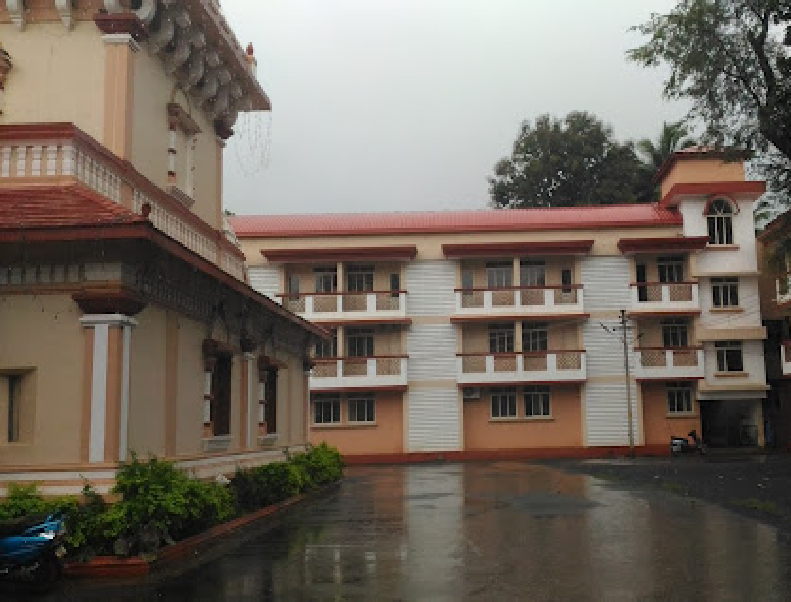History
ॐ HISTORY
History
ॐ ABOUT US
ॐ SHREE SHANTADURGA CHAMUNDESHWARI KUDTARI MAHAMAYA ॐ
Antiquity
In 1510 AD Portuguese invaded Goa and started its conquests. During the mid 16th Century 1543 to 1564 AD conversions and desecration of temples have started on large scale in Goa predominantly by Jesuits sect of Christians. They started desecration of all Hindu temples and also inhuman atrocities in Salcete.
On 1st May 1560 the Jusuits intruded into Cortalim for their ill intentions of forcible conversions in Salcete, and they commenced desecrating Hindu temples. No sooner the Mahajans learnt about the religious intolerance, all the deities from Curtorim were shifted to a safer place. The Mahajans were compelled to abandon their families and house and flee to Karnataka and Kerala with bare minimum belongings, however the faith of these people was kept intact. In 1721 AD a prose has been composed about shifting of deities from Salcete which is included in a book called, “Konkanakhyan”, as under:-
“सासष्ठी देशामाजी वहिले ।
म्हाडगांवीचे देव रीवणास आले ।।
कुडतरी ग्रामीचे पातले ।”
चंद्रवाडी शेळवणासी ।।
Mahajans
Initially the deities were shifted to Shelvona(Xelvon) from there the deities were moved to Ghudo Avede. The original Murtis (idols) of Shree Ganapati which was shifted to Shelvona during initial shifting can be seen till date at Shelvona. The Mahajans and Kulavis of this Devasthan includes people from all stratas of social life. The merciful blessings of this Devi is truly divine and publicily acclaimed. This temple is renowned in Goa as a very lively temple wherein all desires of the devotee come true, hence people keep flocking in the temple from Goa and other States.
Primarily the persons with surnames like Kamat, Kurtarkar, Dessai, Naik, Bhagat, Chari, Pai, Patnekar, Nayak, Bhat, Rao, Sanu, Daivadnya etc. are the Mahajans- Kulavi of this Devasthan. Numerous Mahajans of this Devasthan have settled in other states like Karnataka, Kerala and Maharashtra. It was very difficult for these Mahajans to visit the temple and seek blessings of Devi during pre-liberation era. However now due to infrastructural development people have been benefited.
Devis and Deities
The Chief deities are Shree Shantadurga and Shree Chamundeshwari Kurtari Mahamaya which are installed next to each other but in different Garbhgrah- Sanctum Sanctorum, wherein Devi Shantadurga is on the left side of Devi Chamundeshwari, Shree Udengi diety is pre-existing at the site even prior to the establishment of Devasthan. Shree Udengi deity temple is situated infront of the chief deities in a beautiful and independent temple. Shree Laxminarayan, Shree Ganapati, Shree Mahadev and Shree Grampurush is situated on the right side of the chief deities. Shree Ravalnath is situated on left side of deity whereas Shree Jalmi is situated on the outer wall of the temple. Shree Purva(Mharangan) is situated infront of Udengi. Whereas Shree Prasadling is situated inside the chief deity temple which is of brass metal, Shree Shantadurga, Shree Chamundeshwari, Shree Laxminarayan, Shree Ganapati, Shree Ravalnath are made of black marble and Shree Mahadev and Shree Grampurush are of black marble but in Ling Shape. And Udengi is in natural living anthills shape where a brass snake with five heads is installed. Shree Jalmi, Shree Purva(Mharangan) are in black marble.
As the idols of Shree Shantadurga, Shree Chamundeshwari and Shree Ravalnath became very old it was inevitable to replace the same. The Kaul-prasad was obtained of the Chief Deity and the idols of above deities as well as of Shree Ganapati were replaced by new murtis-idols made of black marble. The re-installation ceremony was held on the auspicious muhurat in Shak 1893 Virodhi Krut naam Smavatsaram, Chaitra Shukla 5/6th , on Mula Nakshaktra, Friday, 16th April, 1971 with all vedic rituals and formalities including Yadnya Yaag. This ceremony was for 06 days from 14th April to 19th April, 1971.
Registration and recognition
Though the devasthan was shifted from Kudtari(Curtorim) to Shelvona and from there to Ghudo Avede and the murtis were re-installed/replaced, the constitution or rules for Devasthan were not codified. The overall administration and religious rituals were carried on by the respective committees from time to time as they felt it appropriate. It was essential to codify the constitution – rules of devasthan for ensuring smooth functioning, comprehensive diurnal administration and to bring in order in its affairs. Hence, on deliberate discussion held in the General Body meeting under chairmanship of then President Dr. Premanand L. Kamat, it was decided to form a committee Under chairmanship of Adv. Narayan Mahadev Dessai. Other members of this committee were Shri. Dilip Kurtarkar, Shri. Chandrakant Bhiso Naik, Shri. Mhabali Sitaram Kurtarkar. The committee gathered the due information and prepared the constitution in 1989 and thereafter on approval of General body the registration with government was completed.
The day to day functions of Executive committee, substitute committee, employees, duties and functions of Mahajans and kulavis has been initiated as per the constitution. Once this constitution got recognized and registered with government the entire administration of devasthan has been carried on in orderly and discipline manner. In order to facilitate all the mahajans, kulavis and devotees the executive committee started the work of residential quarters first. Accordingly the foundation stone was laid on 10th March, 1978 for the said project at the hands of Shri. Dharma Chandru Kurtarkar. With the efforts of all, the project was completed and inaugurated at the auspicious hands of H. H. Shrimad Sacchinandand Saraswati Swamy Maharaj on 12th March, 1986. The ceremony was presided by Advocate Narayan M. Dessai and Shri. Nileshwar Narayan Pai, Mumbai was Chief Guest.
The then executive committee under the Chairmanship of Shri. Narayan Mahadev Dessai decided to renovate the temple in place of existing temple by a beautiful and decorative temple. The renowned architect Shri. Ramesh Kamat and Brothers from Panaji prepared a very beautiful plan for the temple with no cost. The foundation stone for the said renovation of temple was laid at the auspicious hands of H.H. Shrimad Vidhyadhiraj Tirth Vader Swamiji, Partagali Mutt in the presence of Shri. Nileshwar Narayan Pai, Mumbai on 27th December, 1991. The then committee of the devasthan constituted a committee to look after seamless construction and completion of project under the chairmanship of Shri. Venkatesh Kamat. This committee and the executive committee decided to build the sanctum sanctorum of the chief deities first. Accordingly on Margshirsh Vadhya Pratipada shake 1916 i.e. 18th December, 1994 the re-intallation ceremony of idols was held at the auspicious hands of H. H. Shrimad Sacchidanand Saraswati Swamiji in presence of his Patt Shishya H.H. Shivanand Saraswati Swamiji. Since then the said day is celebrated as Smarakotsav- Vardhapan din.
Prasad and Kaul
There is a tradition of obtaining Prasad kaul in the Devasthan. Prasad kaul is sought from Prasad Ling. The white flowers of Tumba tree is used to seek Prasad. Two Prasads can be obtained here at one time wherein the white flowers are used on right side for one person and left side for other person.
The developmental activities of this devasthan have been continued unabated since last 25 to 30 years due to co-operation and help from executive committee, mahajans, devotees and donors. The constructions within the temple premises pertaining to halls, rooms, kitchen block etc, has been not only sustainable to environment and scenic beauty of the area but has added to its beauty of the locality. This temple is considered amongst the most beautiful temples in South Goa. The entire credit of this goes to the almighty Devi, who has got this entire work done from us.
The entire history of this devasthan has been referred from the records of the devasthan also through various writing of Shri Narayan Mahadev Dessai, Shri. Vinayak Shenvi Dhume. The history given in this souvenir would guide the mahajans kulavis and devotees for the days to come. We have made all sincere efforts however we regret if there are any shortcomings.






